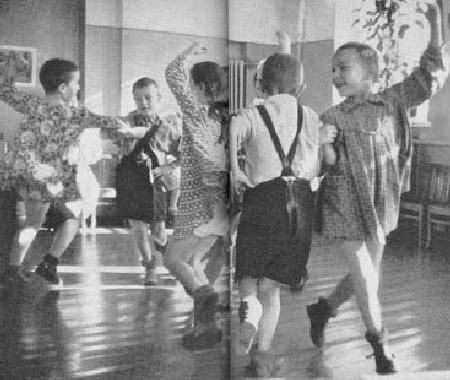
National Dancing Programs

Figure 1.--Soviet schools often gave considerable attention to dance. Great dancers often given the same prestige as star atheletes. We are less sure about the attention given to dance in Russian schools. HBC has no information on this image. We assume that the children in dresses are girls who have had their hair cropped. Hopefully our Russian readers can provide some insights.
|
|
Dance is given widely diiferent attention in different countries and is viewed in very different terms. Here we are not speaking about ethnic dance styles which are addressed above, but rather attitudes toward dance and attention to dance education in different countries. Dance is an integral part of the school ciriculum in some countries, although this has varied over time as well as accross mational borders. Dance has traditionally been more a part of elementary rather than secondary education programs. Even this has varied widely. In the time of tight budgets, dance often gets even less attention than school music programs. Dance has been viewed in very different terms in different countries. In some such as Britain and America, dance has been viewed as efete and boys interested might keep in a secret from their parents. Here social factors were involved with boys from working class familues especially concerned about expressing an interest in dance. This is shown in the British film Billy Elliot. Dance may get more attention in private than in public schools. In other countries such as Ruissia, dance was seen as part of a great artistic heritage and great dancers often given the same prestige as star atheletes.
Many countries have a rich tradition of ethnic dance. Children are often
encouraged to participate as part of efforts to preserve the country's cultural
heritage. There has been a great revival of interest in ethnic dance in America
as second and third generation Ameicans seek to discover their roots. Information
on ethnic festivals in America is available at the
Folk Things website. There are many different forms of ethnic dance. We should stress that ethnic dance is not synonamous with national dance programs. Scottish and Irish step dancing, gor example, is practed in nymerous counries around the world to which the Scotts and Irish have spread. Often there are more dancers outside the the origonal country such as Ireland and Scotland than within.
National Dances
There are many dances associatedwith individual countries that are not ethnic dances. Samba, Gafieira (Samba for two), Lambada and Forró are, for exmple, typical Brazilian dances.
Attitudes toward Dance
Dance is given widely diiferent attention in different countries and is viewed in very different terms. Dance is an integral part of the school ciriculum in some countries, although this has varied over time as well as accross mational borders. Dance has traditionally been more a part of elementary rather than secondary education programs. Even this has varied widely. In the time of tight budgets, dance often gets even less attention than school music programs. Dance has been viewed in very different terms in different countries. Dance ehthisists succeeded tomsome extent during the 1920s and 30s to introduce dance in American schoolrooms, but interest has since wained. In some such as Britain and America, dance has been viewed as efete and boys interested might keep in a secret from their parents. Here social factors were involved with boys from working class familues especially concerned about expressing an interest in dance. This is shown in the British film Billy Elliot. Dance may get more attention in private than in public schools. In other countries such as Ruissia, dance was seen as part of a great artistic heritage and great dancers often given the same prestige as star atheletes. The Soviet prigram of training dancers ia beautifully illustrated in The Children of Theater Street.
HBC

Navigate the Historic Boys' Clothing Web Site:
[Return to the Main dance page]
[Introduction]
[Activities]
[Biographies]
[Chronologies]
[Countries]
[Style Index]
[Bibliographies]
[Contributions]
[FAQs]
[Glossaries]
[Images]
[Links]
[Registration]
[Tools]
[Boys' Clothing Home]
Navigate the Historic Boys' Clothing Web chronological pages:
[The 1900s]
[The 1910s]
[The 1920s]
[The 1930s]
[Thw 1940s]
[The 1950s]
[The 1960s]
[The 1970s]
[The 1980s]
[The 1990s]
Navigate the Historic Boys' Clothing Web style pages:
[Kilts]
[Caps]
[Sailor hats]
[Lederhosen]
[Sailor hats]
Created: May 30, 1999
Last updated: 7:10 AM 4/2/2009



